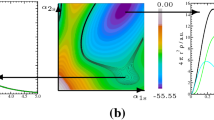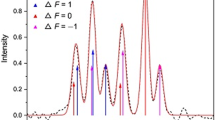Abstract
Orthogonal operators are a next step in the semi-empirical description of complex spectra. Orthogonality yields optimal independence and thus least correlation between the operators. The increased stability of the fitting process is used to include higher-order many-body as well as fully relativistic effects. The calculated eigenvalues are frequently an order of magnitude more accurate with respect to a conventional semi-empirical approach. The resulting eigenvectors may not only be put to use to calculate transition probabilities and g-factors, but also to calculate hyperfine structure A and B constants. We illustrate our first steps in this field with two examples of first spectra of the iron group elements. The results are compared to current experimental hyperfine structure A-values while strong and weak points of the method are discussed. In particular to be able to deal with lanthanides and actinides, the orthogonal operator method is completed with the definition of operators for equivalent p- and f-electrons.
Graphical abstract

Similar content being viewed by others
Data Availability Statement
This manuscript has associated data in a data repository. Data analyzed and presented in this article are available from the corresponding author upon reasonable request.
References
G. Başar, F. Güzelçimen, I. Öztürk et al., Hyperfine structure measurements of neutral vanadium by laser-induced fluorescence spectroscopy in the wavelength range from 750 nm to 860 nm. J. Quant. Spectrosc. Radiat. Transf. (JQSRT) 202, 193–199 (2017). https://doi.org/10.1016/j.jqsrt.2017.07.035
G. Başar, I.K. Öztürk, H. Erdoǧan et al., New even parity fine structure energy levels of atomic vanadium. Spectrochim. Acta Part B: Atom. Spect. 207(106737), 1–8 (2023). https://doi.org/10.1016/j.sab.2023.106737
H. Casimir, Über die hyperfeinstruktur des Europiums. Physica 2, 719–723 (1935). https://doi.org/10.1016/S0031-8914(35)90148-3
J. Childs, O. Poulsen, L.S. Goodman et al., Laser-RF double resonance studies of the hyperfine structure of \(^{51}\)V. Phys. Rev. A 19, 168–179 (1979). https://doi.org/10.1103/PhysRevA.19.168
R. Cowan, The Theory of Atomic Structure and Spectra (University of California Press, Berkeley, 1981)
H. Crosswhite, H. Crosswhite, B. Judd, Magnetic parameters for the configuration \(f^3\). Phys. Rev. 174, 89–94 (1968). https://doi.org/10.1103/PhysRev.174.89
M. Ding, J. Pickering, Comment on: ‘Hyperfine structure measurements of Co I and Co II with Fourier transform spectroscopy’. J. Quant. Spectrosc. Radiat. Transf. (JQSRT) 288(108240), 1–4 (2022). https://doi.org/10.1016/j.jqsrt.2022.108240
H. Dothe, J. Hansen, B. Judd et al., Orthogonal scalar operators for p\(^N\)d and pd\(^N\). J. Phys. B: Atom. Mol. Phys. 18, 1061–1080 (1985). https://doi.org/10.1088/0022-3700/18/6/007
M. Elantkowska, J. Ruczkowski, Dembczyński, Construction of the energy matrix for complex atoms Part VI: core polarization effects. Eur. Phys. J. Plus 131(429), 1–15 (2016). https://doi.org/10.1140/epjp/i2016-16429-3
H. Fu, Y. Xu, D. Fang et al., Hyperfine structure measurements of Co I and Co II with Fourier transform spectroscopy. J. Quant. Spectrosc. Radiat. Transf. (JQSRT) 266(107590), 1–7 (2021). https://doi.org/10.1016/j.jqsrt.2021.107590
P. Głowacki, D. Stefańska, J. Ruczkowski et al., Hyperfine structure investigations of Mn I. J. Quant. Spectrosc. Radiat. Transf. (JQSRT) 287(108245), 1–16 (2022). https://doi.org/10.1016/j.jqsrt.2022.108245
M. Godefroid, Note on the mutual spin-orbit matrix elements J. Phys. B: Atom. Mol. Phys. 15, 3583–3586 (1982). https://doi.org/10.1088/0022-3700/15/20/008
F. Güzelçimen, A. Er, I. Öztürk et al., Investigation of the hyperfine structure of weak atomic Vanadium lines by means of Fourier transform spectroscopy. J. Phys. B: Atom. Mol. Opt. Phys. 48(115005), 1–7 (2015). https://doi.org/10.1088/0953-4075/48/11/115005
J. Hansen, B. Judd, Fine-structure analyses with orthogonal operators. J. Phys. B: Atom. Mol. Phys. 18, 2327–2338 (1985). https://doi.org/10.1088/0022-3700/18/12/012
J. Hansen, B. Judd, G. Lister, Parametric fitting to 2p\(^N\)3d configurations using orthogonal operators. J. Phys. B: Atom. Mol. Phys. 20, 5291–5324 (1987). https://doi.org/10.1088/0022-3700/20/20/009
B. Judd, Three-particle operators for equivalent electrons. Phys. Rev. 141, 4–14 (1966). https://doi.org/10.1103/PhysRev.141.4
B. Judd, H. Crosswhite, Orthogonalized operators for the f shell. J. Opt. Soc. Am. B 1, 255–260 (1984). https://doi.org/10.1364/JOSAB.1.000255
B. Judd, M. Suskin, Complete set of orthogonal scalar operators for the configuration f\(^3\). J. Opt. Soc. Am. B 1, 261–265 (1984). https://doi.org/10.1364/JOSAB.1.000261
B. Judd, H. Wadzinski, A class of null spectroscopic coefficients. J. Math. Phys. 8, 2125–2130 (1967). https://doi.org/10.1063/1.1705129
B. Judd, H. Crosswhite, H. Crosswhite, Intra-atomic magnetic interactions for \(f\) electrons. Phys. Rev. 169, 130–138 (1968). https://doi.org/10.1103/PhysRev.169.130
B. Judd, J. Hansen, A. Raassen, Parametric fits in the atomic d shell. J. Phys. B Atom. Mol. Phys. 15, 1457–1472 (1982). https://doi.org/10.1088/0022-3700/15/10/007
P. Klinkenberg, P. Uylings, The 5f\(^2\)-Configuration in Doubly Ionized Thorium, Th III. Phys. Scr. 34, 413–422 (1986). https://doi.org/10.1088/0031-8949/34/5/010
A. Kramida, Y. Ralchenko, J. Reader, J., NIST atomic spectra database, in NIST ASD Teamhttps://physics.nist.gov/asd. https://doi.org/10.18434/T4W30F. [Online; Accessed 25 December 2023] (2023)
H. Ma, M. Liu, Y. Xu et al., Hyperfine structure constants for neutral and singly ionized vanadium by Fourier transform spectroscopy data. J. Quant. Spectrosc. Radiat. Transf. (JQSRT) 280(108085), 1–7 (2022). https://doi.org/10.1016/j.jqsrt.2022.108085
A. Meftah, J.F. Wyart, W.Ü. Tchang-Brillet et al., Spectrum and energy levels of the Yb\(^{4+}\) free ion (Yb V). Phys. Scr. 88(045305), 1–12 (2013). https://doi.org/10.1088/0031-8949/88/04/045305
P. Palmeri, E. Biémont, P. Quinet et al., Term analysis and hyperfine structure in neutral vanadium. Phys. Scr. 55, 586–598 (1997). https://doi.org/10.1088/0031-8949/55/5/011
J. Pickering, Measurements of the hyperfine structure of atomic energy levels in Co I. Astrophys. J. Suppl. Ser. 107, 811–822 (1996). https://doi.org/10.1086/192382
J. Prince, P. Quinet, Detailed analysis of configuration interaction and calculation of radiative transition rates in seven times ionized tungsten (W VIII). Atoms 3, 299–319 (2015). https://doi.org/10.3390/atoms3030299
P. Quinet, J. Hansen, The influence of core excitations on energies and oscillator strengths of iron group elements. J. Phys. B Atom. Mol. Opt. Phys. 28, L213–L220 (1995). https://doi.org/10.1088/0953-4075/28/7/003
G. Racah, Theory of complex spectra. IV. Phys. Rev. 76, 1352–1365 (1949). https://doi.org/10.1103/PhysRev.76.1352
E. Saloman, A. Kramida, Critically evaluated energy levels, spectral lines, transition probabilities, and intensities of neutral vanadium (VI). Astrophys. J. Suppl. Ser. 231(18), 1–9 (2017). https://doi.org/10.3847/1538-4365/aa7e2a
P. Sandars, J. Beck, Relativistic effects in many electron hyperfine structure I. Theory. Proc. R. Soc. A289, 97–107 (1965). https://doi.org/10.1098/rspa.1965.0251
Y. Shan, A. Reiners, D. Fabbian et al., The CARMENES search for exoplanets around M dwarfs not-so-fine hyperfine-split vanadium lines in cool star spectra. Astron. Astrophys. 654(A118), 1–22 (2021). https://doi.org/10.1051/0004-6361/202141530
Ł Sobolewski, L. Windholz, J. Kwela, Laser spectroscopy used in the investigation of the Zeeman—hyperfine structure of vanadium. J. Quant. Spectrosc. Radiat. Transf. (JQSRT) 242(106769), 1–5 (2020). https://doi.org/10.1016/j.jqsrt.2019.106769
P. Uylings, A. Raassen, Orthogonal operators: applications, origin and outlook. Atoms 7(102), 1–14 (2019). https://doi.org/10.3390/atoms7040102
J.F. Wyart, A. Meftah, W.Ü. Tchang-Brillet et al., Analysis of the free ion \(\text{Nd}^{3+}\) spectrum (Nd IV). J. Phys. B: Atom. Mol. Opt. Phys. 40, 3957–3972 (2007). https://doi.org/10.1088/0953-4075/40/19/013
Author information
Authors and Affiliations
Contributions
PU and TR are both founders of the current orthogonal operator method. PU prepared the manuscript; TR is responsible for analyzing the results, presentation of the tables and critically reading the manuscript.
Corresponding author
Ethics declarations
Conflict of interest
The authors declare no conflict of interest.
Appendix A: p-shell orthogonal operators
Appendix A: p-shell orthogonal operators
The electrostatic structure of \(p^N\) configurations is described by the first-order parameter \(O_2\) and the effective higher-order parameter \(E_{\alpha }\). The contribution of \(F^2(pp)\) is given by:
The magnetic structure is described by the operators \(z_p\), \(z_{\textrm{c}}\) and \(z_3\) for the spin–orbit effects and \(z_1\) for the spin–spin interaction; the associated parameters are \(\zeta _p\), \(A_{\textrm{c}}\), \(A_3\) and \(A_1\), respectively.
The spin–spin operator \(z_1\) has only one nonzero reduced matrix element \({\langle }^{3\!}P \parallel z_1 \parallel ^{3\!\!}P{\rangle }=10\sqrt{3}\). The magnitude of all magnetic operators in \(p^2\) equals 12. The physical content of all the \(p^N\) operators is given in Eqs. (A1), (A2) and (A3). Unlike the case of the d- and the f-shell, no additional three-particle electrostatic operator appears in \(p^3\). For the two-particle magnetic operators \(A_{\textrm{c}}\) and \(A_3\), one obtains the below first- and second-order contributions:
where the electrostatic spin–orbit (EL-SO) contribution \(P^2(p \rightarrow p')\) is given by:
The occurring \(M^0\) integrals are defined in accordance with equation (3) of [12]:
Rights and permissions
Springer Nature or its licensor (e.g. a society or other partner) holds exclusive rights to this article under a publishing agreement with the author(s) or other rightsholder(s); author self-archiving of the accepted manuscript version of this article is solely governed by the terms of such publishing agreement and applicable law.
About this article
Cite this article
Uylings, P., Raassen, T. Orthogonal operators: extension to hyperfine structure and equivalent p- and f-electrons. Eur. Phys. J. D 78, 38 (2024). https://doi.org/10.1140/epjd/s10053-024-00828-4
Received:
Accepted:
Published:
DOI: https://doi.org/10.1140/epjd/s10053-024-00828-4




